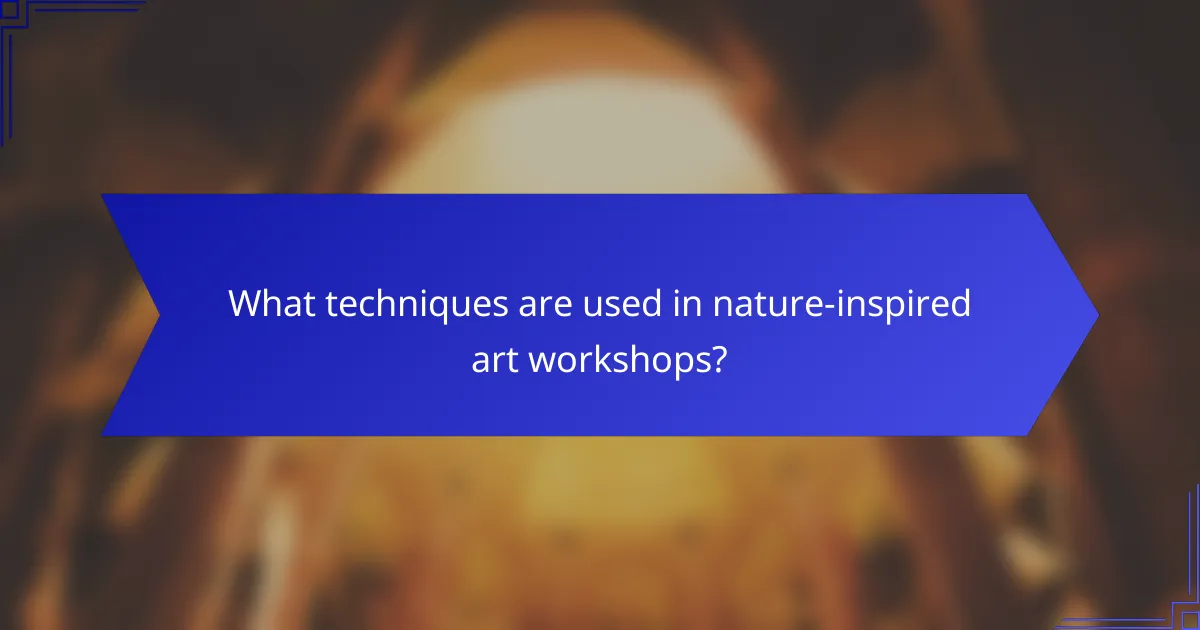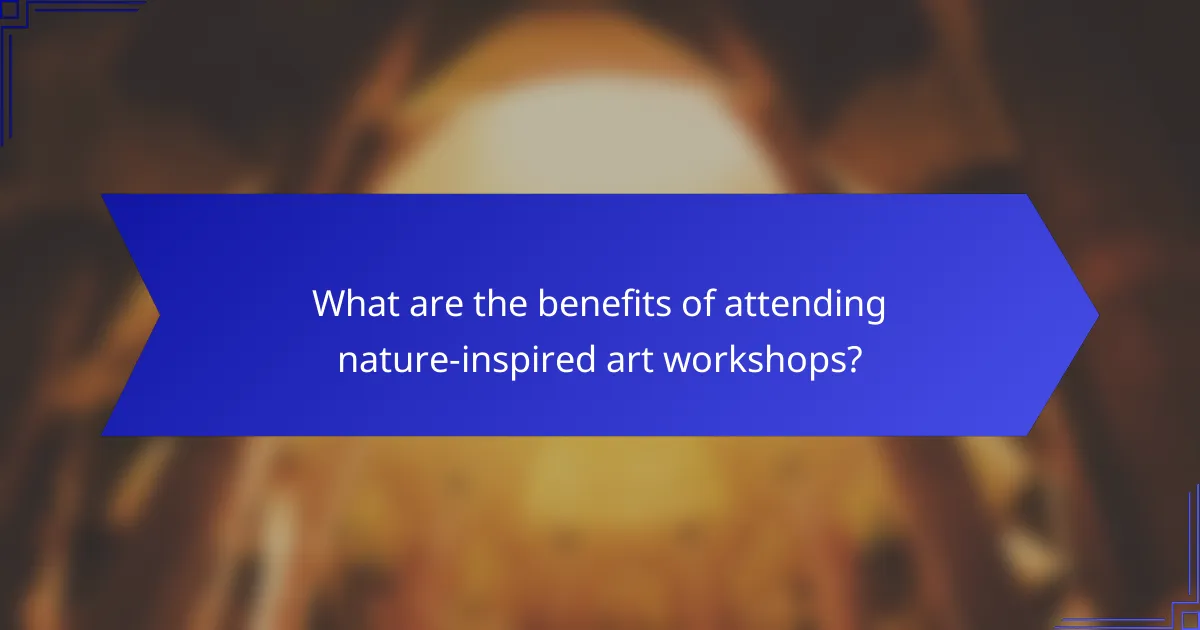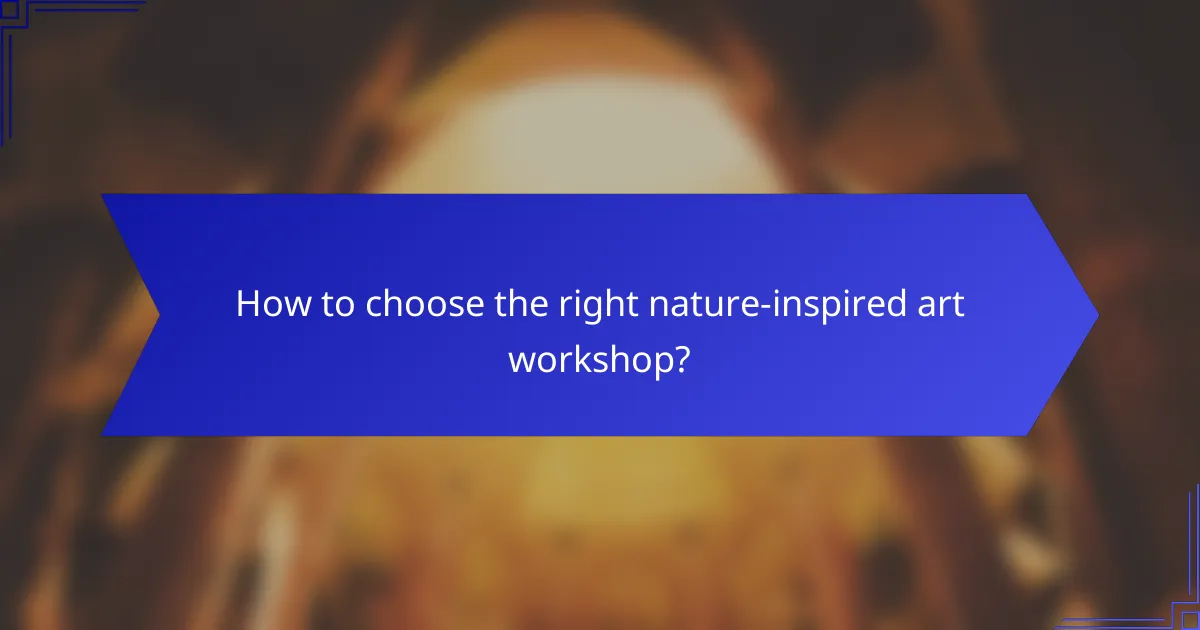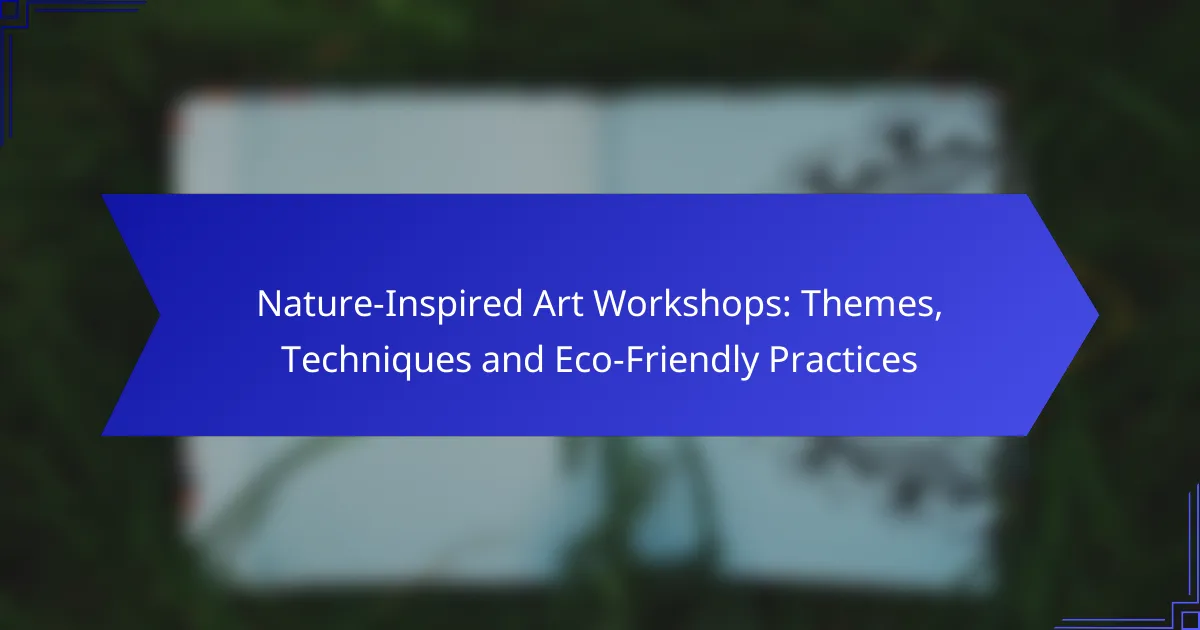Nature-inspired art workshops provide a unique opportunity to explore creativity while deepening appreciation for the environment. By focusing on themes drawn from the natural world, participants engage in various techniques such as watercolor painting, eco-printing, and natural dyeing, all while embracing eco-friendly practices that promote sustainability and responsibility towards nature.

What are popular nature-inspired art workshop themes?
Popular nature-inspired art workshop themes focus on various aspects of the natural world, encouraging creativity while fostering an appreciation for the environment. These themes often incorporate specific techniques and eco-friendly practices, allowing participants to explore art through the lens of nature.
Botanical Illustration
Botanical illustration workshops emphasize the detailed depiction of plants and flowers, blending art with scientific accuracy. Participants learn to observe and capture the intricate details of flora using techniques such as watercolor, pencil, or ink. It’s essential to choose the right materials, like high-quality paper and pigments, to achieve vibrant results.
Consider starting with local plants to create a personal connection to the subject matter. Workshops may also cover the history of botanical art, providing context and inspiration for budding artists.
Land Art
Land art involves creating temporary or permanent installations using natural materials found in the environment, such as stones, leaves, and soil. This theme encourages participants to engage with their surroundings and think about the relationship between art and nature. Projects can range from simple arrangements to more complex sculptures.
When participating in land art workshops, consider the impact of your work on the ecosystem. Use biodegradable materials and avoid disrupting local wildlife. Documenting your creations through photography can also enhance the experience.
Wildlife Photography
Wildlife photography workshops focus on capturing images of animals in their natural habitats. Participants learn techniques for approaching wildlife respectfully and safely while honing their photography skills. Understanding lighting, composition, and camera settings is crucial for achieving stunning results.
It’s advisable to research local wildlife regulations to ensure ethical practices, such as maintaining a safe distance and not disturbing animals. Workshops often include field trips to nearby parks or reserves, providing ample opportunities for practice.
Eco-Friendly Sculpture
Eco-friendly sculpture workshops emphasize the use of sustainable materials and practices in creating three-dimensional art. Participants can work with recycled items, natural materials, or biodegradable substances to craft their sculptures. This theme encourages creativity while promoting environmental awareness.
When selecting materials, consider their lifecycle and environmental impact. Workshops may also discuss the importance of reducing waste and finding innovative ways to repurpose everyday objects into art.
Nature Mandalas
Nature mandalas are circular designs created using natural elements like stones, leaves, and flowers. These workshops focus on the meditative process of arranging materials into intricate patterns, promoting mindfulness and creativity. Participants can explore symmetry and balance while connecting with nature.
Gathering materials from the local environment can enhance the experience, but ensure that you do so sustainably, respecting local flora. Workshops may also incorporate discussions on the cultural significance of mandalas across different traditions.

What techniques are used in nature-inspired art workshops?
Nature-inspired art workshops utilize various techniques that draw from the natural world, allowing participants to explore creativity through organic materials and themes. Common methods include watercolor painting, natural dyeing, eco-printing, clay modeling, and mixed media collage, each offering unique ways to engage with nature’s beauty.
Watercolor Painting
Watercolor painting is a popular technique in nature-inspired art workshops, as it allows for the blending of colors that mimic natural landscapes. Participants often use watercolors to capture the essence of flora and fauna, focusing on light and transparency to create depth.
To get started, gather quality watercolor paper, brushes, and a palette of colors. Experiment with wet-on-wet and wet-on-dry techniques to achieve different effects. A common tip is to work in layers, allowing each layer to dry before adding more detail.
Natural Dyeing
Natural dyeing involves using plant materials, such as leaves, flowers, and roots, to create dyes for fabrics or paper. This technique emphasizes sustainability by utilizing resources that are often readily available in the environment.
To practice natural dyeing, collect materials like onion skins or avocado pits, and follow a simple process of boiling them to extract color. Be mindful of the mordants used, as they can affect the final hue and should be chosen based on the desired outcome.
Eco-Printing
Eco-printing is a technique that transfers the natural pigments from leaves and flowers onto fabric or paper, creating unique, organic patterns. This method celebrates the beauty of nature while promoting eco-friendly practices.
To eco-print, arrange leaves on fabric, bundle tightly, and steam or boil to release the pigments. Experiment with different plant materials to achieve varied results. It’s advisable to use natural fibers like cotton or silk for better color absorption.
Clay Modeling
Clay modeling allows participants to create three-dimensional art inspired by natural forms, such as animals or plants. This tactile technique fosters creativity and connection with the earth.
When working with clay, choose air-dry or kiln-fired options based on your project needs. Start with basic shapes and gradually add details. Remember to keep the clay moist while working to prevent cracking, and consider using natural textures for added interest.
Mixed Media Collage
Mixed media collage combines various materials, such as paper, fabric, and found objects, to create layered artwork inspired by nature. This technique encourages creativity and experimentation with different textures and colors.
To create a mixed media collage, gather materials that resonate with your theme, such as pressed flowers or leaves. Layer these elements on a sturdy base, using glue or gel medium to adhere them. A useful tip is to balance colors and shapes to create visual harmony in your composition.

How do eco-friendly practices enhance art workshops?
Eco-friendly practices enhance art workshops by promoting sustainability and reducing environmental impact. These practices not only foster creativity but also instill a sense of responsibility towards nature in participants.
Use of Recycled Materials
Incorporating recycled materials into art projects can significantly reduce waste and inspire creativity. Participants can use items like old newspapers, glass jars, and scrap fabric to create unique artworks. This approach not only minimizes the need for new resources but also encourages innovative thinking.
When planning a workshop, consider providing a collection point for participants to bring their own recycled items. This not only engages them but also builds a community around sustainable practices.
Biodegradable Paints
Using biodegradable paints is a crucial step in making art workshops more eco-friendly. These paints are made from natural ingredients that break down over time, reducing pollution and harmful waste. Look for brands that are non-toxic and free from harmful chemicals to ensure safety for both artists and the environment.
When selecting biodegradable paints, consider options that meet local safety standards and are easily accessible in your area. Many art supply stores now offer eco-friendly alternatives that are just as vibrant as traditional paints.
Sustainable Sourcing of Supplies
Sourcing art supplies sustainably involves choosing products that are produced with minimal environmental impact. Look for suppliers who prioritize ethical practices, such as using renewable resources and fair labor standards. This not only supports the environment but also promotes social responsibility.
Consider creating partnerships with local businesses that focus on sustainable products. This can help reduce transportation emissions and support your community while providing quality materials for your workshop.
Waste Reduction Strategies
Implementing waste reduction strategies in art workshops can significantly lessen the environmental footprint. Encourage participants to plan their projects carefully to minimize excess materials and provide clear guidelines on how to dispose of waste responsibly.
Consider using a checklist for waste management that includes options for recycling, composting, and reusing materials. This proactive approach can help participants become more mindful of their consumption and waste habits during and after the workshop.

What are the benefits of attending nature-inspired art workshops?
Attending nature-inspired art workshops offers numerous benefits, including enhanced creativity, a deeper connection to the natural world, community engagement, and skill development. These workshops provide a unique opportunity to explore artistic expression while fostering an appreciation for the environment.
Enhanced Creativity
Nature-inspired art workshops stimulate creativity by encouraging participants to draw inspiration from their surroundings. Engaging with natural elements can lead to innovative ideas and unique artistic interpretations. For example, using leaves, stones, or flowers as materials can inspire new techniques and styles.
Additionally, the relaxed atmosphere of these workshops allows for free expression, reducing the pressure often associated with traditional art classes. This freedom can unlock new levels of creativity, making art more accessible and enjoyable.
Connection to Nature
Participating in these workshops fosters a stronger connection to nature, promoting mindfulness and environmental awareness. By working directly with natural materials, participants develop a greater appreciation for the beauty and complexity of the ecosystem. This connection can lead to a commitment to sustainability and eco-friendly practices in everyday life.
Workshops often take place in outdoor settings, enhancing the experience by immersing participants in the natural environment. This immersion can help individuals feel more grounded and connected to the world around them.
Community Engagement
Nature-inspired art workshops often bring together individuals from diverse backgrounds, fostering a sense of community. Participants can share their experiences, ideas, and artistic techniques, creating a supportive environment for collaboration. This social aspect can lead to lasting friendships and networks centered around shared interests in art and nature.
Community engagement can also extend beyond the workshop, as participants may collaborate on local art projects or conservation efforts. This involvement can strengthen community ties and promote collective action towards environmental stewardship.
Skill Development
These workshops provide valuable opportunities for skill development in various artistic techniques. Participants can learn about different mediums, such as watercolor, clay, or mixed media, while exploring nature-themed projects. Instructors often guide participants through hands-on activities, ensuring a practical learning experience.
Moreover, skill development is not limited to artistic techniques; participants can also enhance their observational skills and understanding of natural forms. This holistic approach to learning can improve overall artistic abilities and confidence in creating nature-inspired art.

How to choose the right nature-inspired art workshop?
Selecting the right nature-inspired art workshop involves considering your artistic skills, the themes offered, and the techniques taught. Workshops can vary widely in focus, from painting landscapes to creating sculptures from natural materials, so it’s essential to align your interests and abilities with the options available.
Consider Your Skill Level
Your skill level is a crucial factor when choosing a nature-inspired art workshop. Beginners may benefit from workshops that offer foundational techniques and guided instruction, while more experienced artists might seek advanced classes that allow for greater creative freedom.
Look for workshops that clearly state their target audience. For instance, a beginner workshop might focus on basic drawing or painting techniques, while an advanced workshop could explore mixed media or eco-sculpture. If unsure, consider reaching out to the instructor for clarification on the expected skill level.
Additionally, consider starting with a workshop that offers a mix of skill levels. This can provide opportunities for peer learning and mentorship, enhancing your overall experience.
